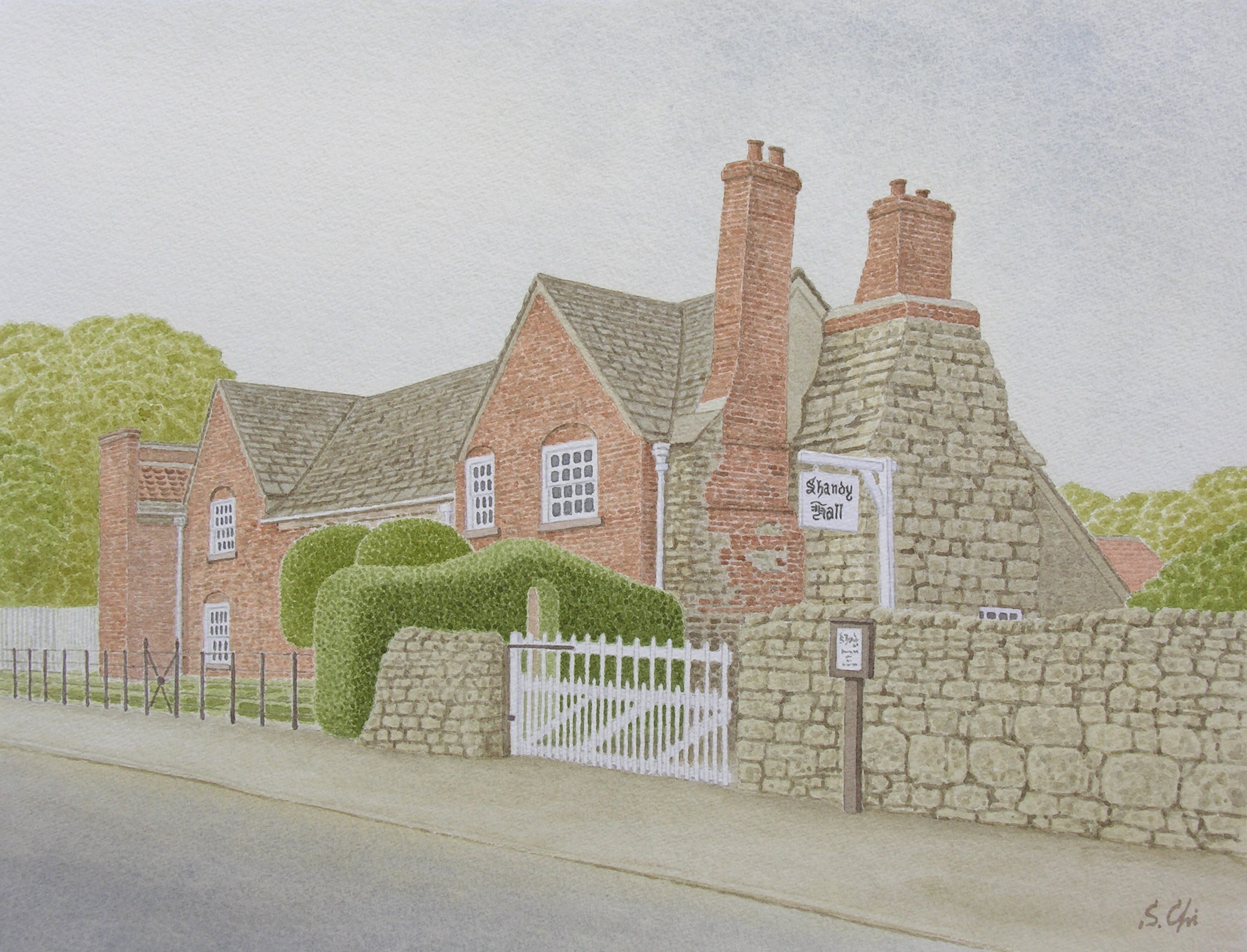
遥かなる わがヨークシャー (Faraway My Yorkshire)
ノース・ヨーク・ムーアズ (The North York Moors)
72 シャンディ・ホール [コックスウォルド] (Shandy Hall, Coxwold)

キルバーンから南東へ4kmほど行ったところに、コックスウォルドの村がある。ここに、18世紀の英文学界でひときわ異彩をはなった作家のロレンス・スターン(1713-1768)が住んでいた牧師館「シャンディ・ホール」がある。
彼が著した型破りの小説『紳士トリストラム・シャンディの生涯と意見』は、20世紀の作家に世界的に大きな影響をあたえた。とくに「意識の流れ」を追求したジェイムズ・ジョイスやマルセル・プルースト、ヴァージニア・ウルフなどは、彼の小説につよい影響を受けているとされている。
しかしスターンの小説は、筋があってないような構成と、前例のない面白半分の表現法などがあり、またその旺盛な批判精神からくる、社会にたいする痛烈な批判と強烈な皮肉や風刺ゆえに、すぐには世に受け入れられなかった。小説が認められて時代の寵児となったときには、彼は結核に侵され、死を意識せざるを得ない状態であった。
ところでスターンの『トリストラム・シャンディ』は、イギリスではどのくらい読まれているのだろうか。日本で彼の名を知っているとすれば、そうとうな英文学通ということになるだろう。まして彼の小説を読んでいるのは、研究者かわたしのような変わり者ぐらいかもしれない。
日本でスターンの影響を受けた作家としては、まず夏目漱石があげられる。彼は明治30年(1897)にスターンのを次のように紹介している。
「今は昔十八世紀の中頃の英国に『ロレンス・スターン』といふ坊主住めり、最も坊主らしからざる人物にて、最も坊主らしからざる小説を著はし、其小説の御蔭にて、百五十年後の今日に至るまで、文壇の一隅に余命を保ち、文学史の出る度に一頁又は半頁の労力を著者に与えるは、作家「スターン」の為に祝すべく、僧「スターン」のために悲しむべきの運命なり、」(『トリストラム・シャンディ』夏目漱石、漱石全集第12巻、岩波書店)
夏目漱石の『吾輩は猫である』の、日常のたわいもない話や風刺、ユーモアをとおして、その奥に流れる人生の機微を描こうとしたスタイルは、まさに『トリストラム・シャンディ』にならったものであろう。
シャンディ・ホールは、いまはロレンス・スターが住んでいたころの状態に再現され、『トリストラム・シャンディ』に関する資料をあつめた資料館になっている。
『トリストラム・シャンディ』は朱牟田夏雄訳の岩波文庫で読んだことがあったが、スターンがヨークシャーに住んでいたことはすっかり忘れていた。シャンディ・ホールのことは、ノース・ヨーク・ムーアズをドライヴしていたときに、たまたま休憩したサットン・バンク・トップのインフォメイション・センターの観光案内で知ったのである。
シャンディ・ホールを1985年の9月にわたしがはじめて訪れたときには、ほかに見学者はなく、ひとりの女性が館内を案内してくれた。あと資料の写真で知ったことだが、彼女はこの資料館の共同名誉館長のジュリア・モンクマン女史であった。
彼女と夫のケネス・モンクマン氏は、長年にわたるスターンの熱心なファンで、書籍はもとより新聞記事など、スターンに関するありとあらゆる資料を世界中から集めていた(朱牟田夏雄訳の岩波文庫版も収蔵しているとのことであった)。そして1967年にロレンス・スターン・トラストを設立し、廃墟となっていたシャンディ・ホールを修復して資料館にしたのである。
『トリストラム・シャンディ』はブロンテ姉妹の小説ほど一般的でないせいか、シャンディ・ホールは訪れる人も少なく、いつ行ってもひっそりとしていた。わたしの最初の訪問者番号は、開館してから12年目であったが、763番だった。
シャンディ・ホールから東へすこし行ったところに、セント・マイケルズ教会がある。ユニークな八角形の塔をもち、ヨークシャーでももっとも美しい教会の一つとされているところである。
その教会の南側のポーチを出たすぐ左の、教会の壁ぎわに、スターンの墓がある。
墓碑銘は、彼がふざけたときによく発したという「ああ、あわれヨリックよ」からはじまる。
ちなみに、この言葉はシェイクスピアの『ハムレット』にある台詞からきているが、ヨリックとは、『トリストラム・シャンディ』にでてくる牧師の名前でもある。そしてそのヨリックは、『ハムレット』にでてくるおしゃべりな道化師のヨリックの子孫ということになっている。
墓碑にはそのあとに、スターンをたたえるん次のような言葉がつづいている。
「スターンは、健全な理性に熱い心と人間性、汚れなき魂と強靭な精神力をもって、世にはびこるあまたの愚かさに巨人のような歩で立ち向かい、大鎌をふるってなぎ倒し、不滅の名声を勝ち得た男であった」
Two and a half miles on the south-east of Kilburn is a village of Coxwold.
There is situated Shandy Hall, a vicarage where Laurence Sterne lived,
now a museum.
He was not only an ecclesiastic but a writer, who wrote the novel "The
Life and Opinions of Tristram Shandy, Gentleman" and stood out prominently
in the 18th century English literary world.
The novel, with both unusual form and substance, is said to have influenced
many writers of the 20th century worldwide. He was not recognized at first
because of his sharp criticism of society and bitter sarcasm or satire
on it. When his novel got to be accepted by the society, Sterne was suffering
from tuberculosis and could not but conscious of death.
I wonder how many English have ever read his novel "Tristram Shandy".
Well-informed Japanese on English literature might know the name of him,
but only scholars or men of great learning or eccentric men like me have
read the novel.
Souseki Natsume(1867-1916), sent to London by the Japanese government to
study English in 1900, introduced Laurence Sterne into Japan. He is one
of the greatest and most popular modern writers in Japan, so to speak,
just like Charles Dickens in Britain, though his style of novels is different
from Dickens completely.
Natsume is said to be one of the writers influented most by Laurence Sterne. He described Sterne as follows in 1897.
"It was the old days of the middle 18th century in England when one priest (Natsume used a word more slighted) named Laurence Sterne lived. Being a person not suitable for a priest, wrting a novel not suitable for his profession, and owing his success in the novel, he has lived in the corner of the literary world until today for a hundred and fifty years, and has troubled the writer of an English literature with labour to write one or a half of page for him whenever a book on the history of literature was published. It is destiny to be congratulated for Sterne as a writer but be deplored for him as an ecclesiatic."
Nastume, having been influenced by the style of "Tristram Shandy",
wrote his first novel "Wagahai wa Neko de Aru" (I Am a Cat) in
1905. The novel is written in the first person by a cat, the pet of a middle
school (present high school) teacher, Kusyami Chinno. The daily life of
her master and events happened around him are depicted. Silly and nonsense
conversations among the teacher and his friends in the novel remind the
readers of those of ones among "my father", "my uncle Toby"
and "corporal Trim" of "Tristram Shandy".
I read the novel in Japanese translated by Natsuo Syumuta, who obtained
a good reputation for its excellent translation, but I didn't remember
Sterne had lived in Yorkshire. Driving the North York Moors, I got the
information on Shandy Hall at the information centre of Sutton Bank Top
by chance.
When I visited the Shandy Hall in September 1985 for the first time, I
was the only visitor. One lady guided me there. I knew later she was Julia
Monkman, joint Hor. Curator of Shandy Hall. She and her husband Kenneth
have been keen fans of Sterne and have collected everything relating to
Sterne and his novels. They established the Laurence Sterne Trust in 1967
and made great sfforts to repair ruined Shandy Hall in order to make it
a museum.
My visitor's number was 763. I put a sheet of the number at the front page
of the book of Tristram Shandy I bought there. Sterne's novel is not as
popular as those of the Brontёsisters, so ther were few visitors in Shandy
Hall whenever I visited.
To the east of Shandy Hall, there is St Mickael's Church. Having an octagonal
tower, the church is said to be one of the most beautiful church buildings
in Yorkshire.
Going out to the churchyard through the south porch, I found the gravestorne
of Sterne against the south wall of the church just on the left hand. The
epitaph of it began with "Alas, poor Yorick!", words which he
is said to have utterd when he frolicked, and the words admiring him followed:
If a sound head, warm heart and breast humane
Unsullied worth and soul without a stain
If mental pow'rs could ever justly claim
The well won tribute of immortal fame,
STERNE was THE MAN, who with gigantic stride
Mow'd down luxuriant follies far and wide.